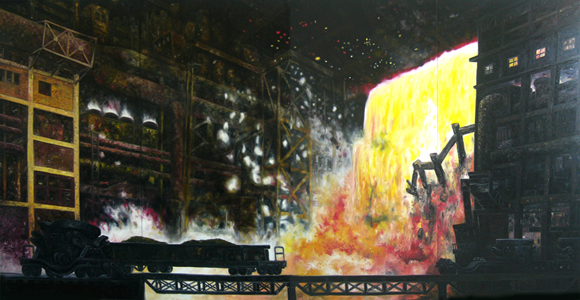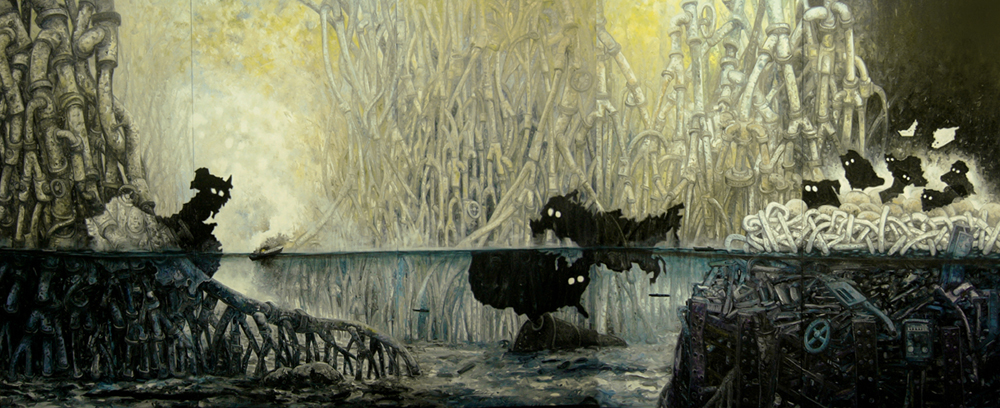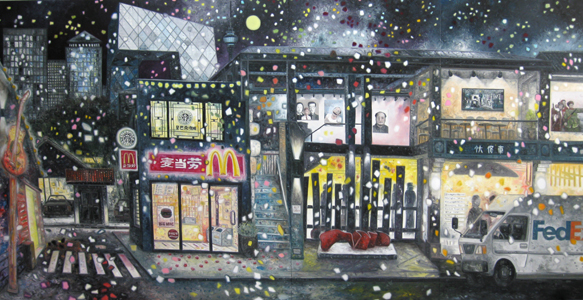
|

Golden Fall , 2008, oil on canvas 227 x 444 cm |

Ghosts, 2008, oil on canvas 227 x 555cm |

City from the Past, 2008, oil on canvas 227 x 444 cm |

City from the Future, 2008, oil on canvas 227 x 444 cm |
The urban gaze of Oscar Oiwa by Angelo BucciDuring the celebrations of the Chinese New Year 2009 a renowned and yet unfinished skyscraper was ablaze in Beijing. In São Paulo, images of the major fire were broadcast live on television. The impact of that episode brought to mind the scene in City from the Future that Oscar Oiwa had painted on canvas the previous year, at his New York studio. In this painting, the same building - CCTU Complex - is featured as an intact edifice, built to conclusion, and definitely an integral element of the Beijing cityscape. City from the Future reveals some features of Oiwa's work by delivering news with the minutiae of a cartoon, heralding urgencies with the dimensions of graffiti, building landscapes out of fragments like a mosaic and, at the same time, extracting such fragments from the urban context Š in collage-like manner. On the other hand, this canvas is not restricted to anything; it reaches beyond to reveal the informed and critical urban experience imprinted in the artistÕs remarkable body of metropolitan works. In fact, the three major cities that on the occasion were fortuitously brought together integrate the artist's habitual circuit. Nowadays, Oscar Oiwa addresses the world. Notwithstanding, I wish to make a note of an earlier time and place, namely the period of consolidation of the lifelong artistic project that Oiwa conceived at the University of São Paulo's School of Architecture and Urbanism, in which we both enrolled in 1983. As early as in those days, Oiwa devised a number of procedures that have charged his work practice with sufficient vigor to last and mature over time, as well as the lasting, comprehensive approach that has enabled him to keep on expanding his dialogue field, again and again. At architectural school, Oscar Oiwa successfully achieved a then challenging and unlikely feat: he created his own launch pad. In 1983, São Paulo presented a contradictory scenario, particularly to the younger generation: on the one hand, there was hope springing up from the imminent process of political opening; on the other hand, there was a desolated cultural scene following devastation by the military dictatorship that lasted from 1964 to 1985. In other words, the city waved with a still blurred possibility and the anguish of immediate cultural precedents that would allow the development of a sound project. Or yet, there was an eagerness for launching and the lack of a reliable launching pad. This scene also prevailed at the school of architecture. However, Oiwa was not impressed by it. As it seems, as early as in his first year of university, he had an inner certainty and a defined goal: to become an artist. Having materialized onto a studio wall on campus, this clear conviction lives on in the form of a 22-meter-long mural painting that Oscar Oiwa joined by a small group of classmates executed under his leadership. At the same time and unlike frequently seen, Oiwa's inner certainty did not make him impervious or averse to academic subjects. On the contrary, he availed himself of an architectural repertoire and the observation of urban themes taken from São Paulo's typically metropolitan scale to accouter his own artistic arsenal. I mean to say in that place and time Oiwa definitely merged into his artistic project the approach of the architect that he was to become. I would like to depart from the manifestations of Oiwa's architectural approach to works of painting to indentify that which I view as a crucial point of my peripheral reading. On a visit to Oiwas's New York home and studio, his overall body of works that include paintings in progress and finished pictures may be interpreted as a discerning collection of city fragments. Here I am neither referring to any specific building or urban cutout, nor to the depiction of urban scenes. The artist's process is quite distinct. I believe it harks back to his formative years in São Paulo, a metropolis of such giant scale (population: 20 million) that it cannot be taken in whole, and the meaning of which cannot be pieced together except fragment by fragment, so as to compose a whole that, however, is not just the sum total of the parts addition. Oscar Oiwa adopts a procedure developed in the São Paulo environment to cast fragments on canvas, just as architects cast them on their architectural plans. To the artist, the city doubles as source and target of his reflections. It is at once the universe of possibilities and his single possible interlocutor. Therefore, city fragments constitute sheer propositional power in the artist's collection. In other words, Oiwa carefully removes them from their original arrangement or urban context, as if to free them, only to provide them with a propositional power once again. Thus, city fragments represent power in the discourse of the artist who uses them to compose new statements that he casts on canvas. This initial procedure - the fragment turned into power to compose a new statement - is clearly demonstrated as different possibilities in space in works such as Apartment (2006), Holes (2003), Post-modern architecture (2003), and Solar Eclipse (2003), or even as possibilities in time, as for example in City from the Past (2008) or City from the Future (2008). Furthermore, the outcome of this first procedure has led the artist to turn to other significant recourses that include transposition of meanings. Such was the case, for instance, with Banana (1984), featuring a São Paulo public square as a banana by taking the color pattern of the elements that took over its space in haphazard manner; Dog = 10 m3 air by day (1994-5), in which a dog is shown next to a balloon representing the daily amount of air it consumes; WWW.Com (2004), featuring a meat market in which the hanging pieces of meat are shaped like country maps, as if they were actually shaped with the human flesh of their inhabitants; or Asian Kitchen (2008), bringing deviated notions of space, time, scale and matter. For a long time now Oscar Oiwa's dialogue arena has extended beyond the metropolitan boundaries of São Paulo to make way in the world. At this moment, in his New York studio, he is preparing an exhibition of eight large-format canvases to be held at BTAP gallery, in Beijing. My presentation briefly revisits a small stretch of Oscar Oiwa's career that I have been privileged to accompany -- at first, from up close, and later, from the distance. I believe that his four years of architecture school were crucially important for the development and maturing of his work process and his approach to painting. However, as I have mentioned, this is my peripheral reading. The focal point of his work is manifestly in the craft to which he devotes himself with masterful skills and admirable consistency. It is, therefore, in practice that Oscar Oiwa ascertains both the regularity and the top quality of his art production. Today I know for sure that the pad from which Oiwa launched himself more than twenty years ago was too unstable to ensure him a safe launching. Even so, he was quite successful at it. His achievement makes the same path accessible to potential followers that, I am sure, will be many.
Angelo Bucci was born in October, 1963. Holds a bachelor's degree in architecture from the University of São Paulo (1987) and a PhD degree in architecture from the same university (2005). Founder and principal in charge of the architectural firm SPBR arquitetura since 2003. Professor at the University of São Paulo's School of Architecture and Urbanism (FAU/ USP) since 2001.Visiting Professor at GSD Harvard, Cambridge, USA (2008); MIT, Cambridge, USA (2008); IUAV, in Venice, Italy (2008); University of California at Berkeley, CA, USA (2006); Torcuato Di Tella University, in Buenos Aires, Argentina(2006), and Arizona State University, in Phoenix, AZ, USA(2005), among others.
|